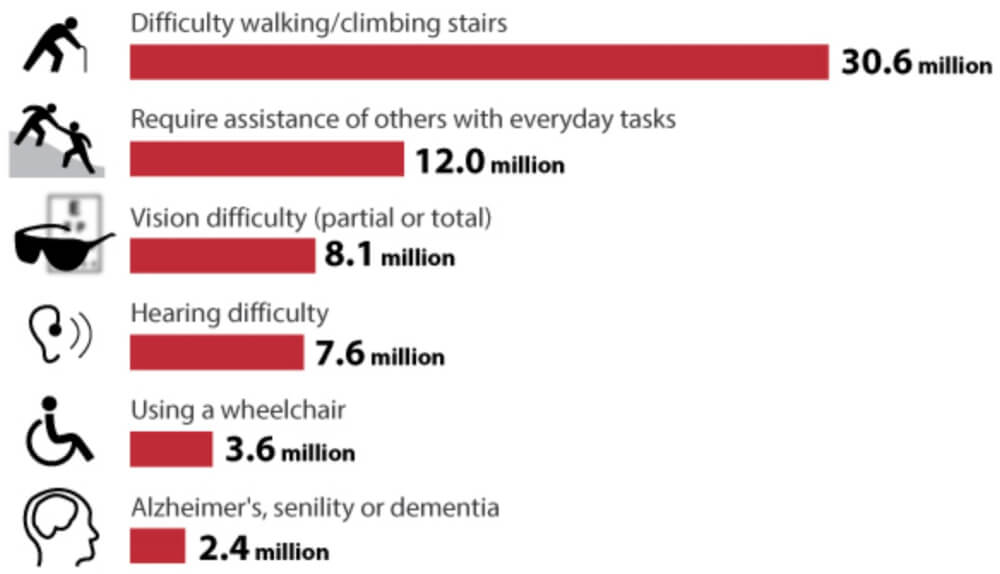The Centers for Disease Control and Prevention (CDC) report that 61 million Americans have some form of disability, affecting one in four people.
There are a lot of things that can make one application for disability benefits more likely to be accepted than another. You may gauge the strength of your claim by learning what types of conditions often receive approval.
The legal meaning of disabled is a person who can’t do any significant work or substantial gainful activity (SGA) because of a medical or physical impairment that is likely to cause death or has lasted or will last for at least 12 months.
But what is the most approved disability for SSDI? Our article aims to help you answer the issue by providing insight and useful recommendations.
Understanding Social Security Disability Benefits
Understanding what constitutes “disability” when applying for Social Security disability benefits is anything but simple.
The term “Social Security Disability” refers to two different types of benefit programs: Social Security Disability Insurance (SSDI) and Supplemental Security Income (SS). But SSDI is a common abbreviation for both programs.
While they share the goal of providing financial assistance to those who are disabled, eligibility for one does not guarantee acceptance into the other.
What Medical Conditions Are Recognized as Disabilities?
Disability benefits may be granted for tens of thousands of different conditions.
Anyone who cannot work due to a medical condition can receive monthly benefits from the Social Security Administration’s Blue Book.
However, certain disorders qualify more frequently for disability claims than others.
There are 14 groups of medical problems that the Social Security Administration considers disabling.
- Musculoskeletal system disorders
- Special senses and speech disorders
- Respiratory disorders
- Cardiovascular system
- Digestive system
- Genitourinary disorders
- Hematological disorders
- Skin disorders
- Endocrine disorders
- Congenital disorders that affect multiple body systems
- Neurological disorders
- Mental disorders
- Cancer (malignant neoplastic diseases)
- Immune system disorders
To qualify for disability benefits from the Social Security Administration (SSA), a person’s disabilities must be severe enough, regardless of the underlying medical condition.
“Most approved disability” is the category of disability for which the most significant number of disability applications have been granted.

Common Medical Conditions Approved for Disability Benefits
Learning about disabilities requires digging into the many disabilities people face.
According to the most recent data from the Social Security Administration (SSA), more than 10 million people are currently receiving benefits from Social Security due to disabilities.
Despite the challenge of identifying the most frequently and commonly approved conditions of disability, some conditions tend to receive frequent approvals due to their significant impact on individuals’ lives.
Click here to learn more about what conditions automatically qualify for disability benefits.
Musculoskeletal System and Connective Tissue
As per the SSA, the most common category approved for disability claims is musculoskeletal and connective tissue conditions. It has been diagnosed among disabled workers receiving disability payments.
It accounted for 34% of the total benefits, including nervous system disorders, musculoskeletal system impairments, and tendon and ligament impairments.
Among the conditions that fit this category are:
- Arthritis
- Rheumatoid arthritis
- Fibromyalgia
- Spine disorders
- Scoliosis
- Ruptured discs
- Carpal tunnel syndrome
- Degenerative disc disease
- Reflex Sympathetic Dystrophy
Musculoskeletal problems like arthritis are more common after the age of 50. The majority of people receiving SSDI for musculoskeletal conditions in 2021 were middle-aged.
That’s 2.4 million Americans with severe pain conditions such as osteoporosis, fibromyalgia, and persistent back pain.
Mental Disorders
The second rank in the most approved social security disability claim has been granted to mental or mood disorders, as per recent data on Social Security Disability Insurance, with roughly 30% of the total disability benefits.
According to the SSA, several mental disorders exist.
- Mood disorders
- Major depressive disorder
- Anxiety and Depression
- Organic mental disorders
- Post-traumatic stress disorder
- Schizophrenia or other psychotic disorders
- Mental illness
- Drug addiction
To qualify for benefits in the category, people must have a neurological condition that a doctor has determined severely limits their ability to live independently.
Nervous System and Sense Organs
In the fourth position, at 10%, were medical impairments of the nervous system.
Johns Hopkins Medicine lists the following as conditions or diseases affecting the neurological system:
- Disorders like polio and meningitis
- Diseases of the nervous system, such as epilepsy and neuralgia
- Diseases that progressively deteriorate over time include multiple sclerosis and Parkinson’s.
- Traumatic brain and spinal cord injuries, along with structural abnormalities such as Bell’s palsy
- Blindness and deafness also appear to fall within this category
Cardiac and Circulatory Disorders
According to Social Security Disability Insurance, approximately 8% of serious disability benefit recipients suffer from a circulatory disorder.
Circulatory disorders affect the blood supply to the heart and other body parts. Examples are:
- Angina
- Heart attack
- Atherosclerosis
- Arrhythmia and dysrhythmia
- Heart failure
- Congenital heart defects
- High cholesterol or high blood pressure
- Stroke
- Peripheral artery disease (PAD)
Intellectual disabilities
Limitations in the following areas are considered to be indicative of an intellectual disability by the American Association on Intellectual and Developmental Disorders (AAIDD):
- Understanding, thinking, and solving
- Behavioral flexibility
Also, problems with learning, memory, and communication are common among people with intellectual disabilities.
Many cases of intellectual disability manifest themselves before the age of 18. They account for 3.9% of people receiving Social Security Disability benefits.
Injuries
Disabilities are a common result of physical injuries; an unexpected injury might drastically alter a person’s life. They might not be able to work at all, or at least not as well as previously.
Those who are disabled due to injuries may qualify for social security benefits more often than others.
According to SSA statistics, injuries accounted for 3.5% of all cases of disability benefits, ranking them as the fifth most approved disability.
Serious injuries, such as bone fractures, joint dislocations, severe burns, and internal bleeding, can significantly impair a person’s functioning ability.
Traumatic Brain and Spinal cord injuries and amputations may also qualify those affected for Supplemental Security Income.
Neoplasms (Cancer)
Neoplasms are clusters of malignant cells. They are sometimes referred to as tumors. Malignant tumors are cancerous, while benign tumors are not.
The disabling consequences of cancer and its treatments sometimes lead to the approval of SSDI payments, especially when the cancer is in an advanced stage or of an aggressive variety.
The SSA estimates that 3.4% of 2021 benefit recipients have a neoplastic disability, ranking them in 7th place.
Individuals diagnosed with leukemia, lung cancer, or breast cancer have been granted SSDI benefits more frequently. During the evaluation procedure, the severity and impact of the disease on an individual’s capacity to work are considered.
Respiratory System Disorders
People with trouble breathing may be eligible for Social Security Disability benefits.
The SSDI has reported that almost 2.7% of total disability claims were for respiratory illnesses.
There is no doubt that respiratory conditions like chronic obstructive pulmonary disease (COPD), asthma, and cystic fibrosis can contribute to breathing issues and their subsequent impact on productivity.
Endocrine and Metabolic Disorders
Several endocrine problems and metabolic disorders might hinder a person’s capacity to work and make them eligible for SSDI. Even 2.5% of all disability claims also received benefits.
Diabetes mellitus, diabetes insipidus, gout, cystic fibrosis, and thyroid disorders all fall into the endocrine category.
Most of these conditions usually don’t cause disability at first. However, when complications grow so severe that they interfere with everyday life, they become a severe disability.
Digestive and Genitourinary-related disorders
Disabilities connected to the digestive system or urinary tract might be severe enough to warrant consideration for Social Security Disability Insurance (SSDI) benefits.
1.6% of all beneficiaries have claimed one of the digestive conditions on the list, which include diverticulitis, gastric or peptic ulcers, ulcerative colitis, and liver cirrhosis.
Similarly, common genitourinary disorders that may meet the criteria for SSDI eligibility include renal problems, prostate-related conditions, end-stage renal diseases, and transplant-related complications.
All of the accounts mentioned above total 2% of disability claims.
Possible Indicators Of Approved Disability Claims
While inconclusive, these indicators should support your claim that you can no longer work due to disability. The indications that your disability claim will be approved include the following:
Prove Your Inability to Work
You must prove that you cannot participate in Substantial Gainful Activity (SGA) and haven’t been able to work for 12 months by giving proof from your work records, such as monthly bank records and paystubs from your company.
Earned Work Credits
To get Social Security disability benefits, you must have a certain number of work credits. Age and years of service together determine your total number of work credits.
For 2023, you must have earned $1640 to earn one work credit, and you can earn up to four work credits for each year of productive employment.
The Blue Book Value for Your Condition
If your condition is listed in the SSA’s Blue Book of debilitating conditions, you can get approved for disability benefits. Residual Functional Capacity can determine your eligibility for disability even if you do not meet a Blue Book classification.
Provide a Good Amount of Medical Evidence
Your chances of being approved for disability increase proportionately to the weight given to the medical evidence supporting your claim that your limitation prevents you from working.
It’s a good idea to talk to a social security disability attorney if you think you could be eligible for disability benefits. When applying for disability benefits, keeping all of the essential documentation in order, and preparing an appeal, having legal representation is invaluable.
Conclusion
Disabilities restrict thousands of Americans from leading an everyday, productive life each year. Some people, however, bear their pain in silence rather than getting the assistance they need.
Although it is challenging to determine the most frequently approved disability due to its significant impact on a person’s life, mobility impairments, intellectual disabilities, and mental health issues are among the most frequently approved ones.
Also, considerations such as medical records, functional limits, legal standards, and individual situations play a role in the application process.

